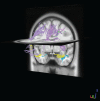Identification of Superficial White Matter Abnormalities in Alzheimer's Disease and Mild Cognitive Impairment Using Diffusion Tensor Imaging
- PMID: 32206757
- PMCID: PMC7081087
- DOI: 10.3233/ADR-190149
Identification of Superficial White Matter Abnormalities in Alzheimer's Disease and Mild Cognitive Impairment Using Diffusion Tensor Imaging
Abstract
Background: Diffusion tensor imaging (DTI) estimates the microstructural alterations of the brain, as a magnetic resonance imaging (MRI)-based neuroimaging technique. Prior DTI studies reported decreased structural integrity of the superficial white matter (SWM) in the brain diseases.
Objective: This study aimed to determine the diffusion characteristics of SWM in Alzheimer's disease (AD) and mild cognitive impairment (MCI) using tractography and region of interest (ROI) approaches.
Methods: The diffusion MRI data were downloaded from the Alzheimer's Disease Neuroimaging Initiative (ADNI) database on 24 patients with AD, 24 with MCI, and 24 normal control (NC) subjects. DTI processing was performed using DSI Studio software. First, for ROI-based analysis, The superficial white matter was divided into right and left frontal, parietal, temporal, insula, limbic and occipital regions by the Talairach Atlas, Then, for tractography-based analysis, the tractography of each of these regions was performed with 100000 seeds. Finally, the average diffusion values were extracted from voxels within the ROIs and tracts.
Results: Both tractography and ROI analyses showed a significant difference in radial, axial and mean diffusivity values between the three groups (p < 0.05) across most of the SWM. Furthermore, The Mini-Mental State Examination was significantly correlated with radial, axial, and mean diffusivity values in parietal and temporal lobes SWM in the AD group (p < 0.05).
Conclusion: DTI provided information indicating microstructural changes in the SWM of patients with AD and MCI. Therefore, assessment of the SWM using DTI may be helpful for the clinical diagnosis of patients with AD and MCI.
Keywords: Alzheimer’s disease; diffusion tensor imaging; mild cognitive impairment; superficial white matter; tractography.
© 2020 – IOS Press and the authors. All rights reserved.
Conflict of interest statement
The authors disclose no conflicts of interest.
Figures



Similar articles
-
Features of the superficial white matter as biomarkers for the detection of Alzheimer's disease and mild cognitive impairment: A diffusion tensor imaging study.Heliyon. 2022 Jan 8;8(1):e08725. doi: 10.1016/j.heliyon.2022.e08725. eCollection 2022 Jan. Heliyon. 2022. PMID: 35071808 Free PMC article.
-
Effectiveness of regional DTI measures in distinguishing Alzheimer's disease, MCI, and normal aging.Neuroimage Clin. 2013 Jul 27;3:180-95. doi: 10.1016/j.nicl.2013.07.006. eCollection 2013. Neuroimage Clin. 2013. PMID: 24179862 Free PMC article.
-
Ultrastructural hippocampal and white matter alterations in mild cognitive impairment: a diffusion tensor imaging study.Dement Geriatr Cogn Disord. 2004;18(1):101-8. doi: 10.1159/000077817. Epub 2004 Apr 14. Dement Geriatr Cogn Disord. 2004. PMID: 15087585
-
The role of diffusion tensor imaging and fractional anisotropy in the evaluation of patients with idiopathic normal pressure hydrocephalus: a literature review.Neurosurg Focus. 2016 Sep;41(3):E12. doi: 10.3171/2016.6.FOCUS16192. Neurosurg Focus. 2016. PMID: 27581308 Review.
-
The role of diffusion tensor imaging in detecting microstructural changes in prodromal Alzheimer's disease.CNS Neurosci Ther. 2014 Jan;20(1):3-9. doi: 10.1111/cns.12166. Epub 2013 Dec 12. CNS Neurosci Ther. 2014. PMID: 24330534 Free PMC article. Review.
Cited by
-
Imaging of the superficial white matter in health and disease.Imaging Neurosci (Camb). 2024 Jul 22;2:imag-2-00221. doi: 10.1162/imag_a_00221. eCollection 2024. Imaging Neurosci (Camb). 2024. PMID: 40800408 Free PMC article.
-
Brain pathological changes during neurodegenerative diseases and their identification methods: How does QSM perform in detecting this process?Insights Imaging. 2022 Apr 13;13(1):74. doi: 10.1186/s13244-022-01207-6. Insights Imaging. 2022. PMID: 35416533 Free PMC article. Review.
-
Features of the superficial white matter as biomarkers for the detection of Alzheimer's disease and mild cognitive impairment: A diffusion tensor imaging study.Heliyon. 2022 Jan 8;8(1):e08725. doi: 10.1016/j.heliyon.2022.e08725. eCollection 2022 Jan. Heliyon. 2022. PMID: 35071808 Free PMC article.
-
The Neural Mechanisms of Tinnitus: A Perspective From Functional Magnetic Resonance Imaging.Front Neurosci. 2021 Feb 11;15:621145. doi: 10.3389/fnins.2021.621145. eCollection 2021. Front Neurosci. 2021. PMID: 33642982 Free PMC article. Review.
-
Diffusion Tensor Imaging Profiles Can Distinguish Diffusivity and Neural Properties of White Matter Injury in Hydrocephalus vs. Non-hydrocephalus Using a Strategy of a Periodic Table of DTI Elements.Front Neurol. 2022 Jul 6;13:868026. doi: 10.3389/fneur.2022.868026. eCollection 2022. Front Neurol. 2022. PMID: 35873785 Free PMC article.
References
-
- Tang SX, Feng QL, Wang GH, Duan S, Shan BC, Dai JP (2017) Diffusion characteristics of the fornix in patients with Alzheimer’s disease. Psychiatry Res Neuroimaging 265, 72–76. - PubMed
-
- Schouten TM, Koini M, Vos F, Seiler S, Rooij M, Lechner A, Schmidt R, Heuvel MVD, Grond JV, Rombouts S (2017) Individual classification of Alzheimer’s disease with diffusion magnetic resonance imaging. Neuroimage 152, 476–481. - PubMed
-
- Hesseltine SM, Ge Y, Law M (2007) Applications of diffusion tensor imaging and fiber tractography. Appl Radiol 36, 8.
-
- Mori S, Crain BJ, Chacko VP, van Zijl PC (1999) Three-dimensional tracking of axonal projections in the brain by magnetic resonance imaging. Ann Neurol 45, 265–269. - PubMed
Grants and funding
LinkOut - more resources
Full Text Sources

